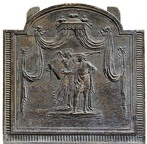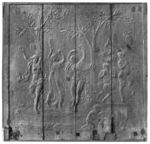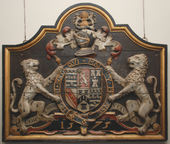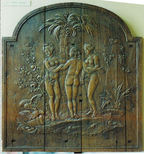-
1139
Description: Carved wooden fireback pattern. Arched rectangular shape; fillet edging to a rounded frame with sections of acanthus leaves at the corners and at the top of the arch, and blank campartments in between; astragal and fillet inside edging; arched rectangular inscription scroll suspended with faux ribbon from the top of the arch; below, a coronet over a large baroque cartouche containg two oval shields: Massenbach - azure two bars or, d'Helmstadt - argent a crow sable; on either side, lion rampant reguardant supporters; four vertical planklines.
Notes: A finely executed carving. Nicolas de Massenbach (1659-1722) and Francoise d'Helmstadt (d.1729) were married at Ourches-sur-Meuse, in Lorraine, in 1695.
Inscription: NDM 1710 FDH
Arms: Nicolas de Massenbach and Francoise d'Helmstadt
- Decoration tags:
- rectangular with round arch (shape)
- fillet (edging)
- whole carved pattern
- planklines
- heraldic
- armorial
- text
Manufactured: in 1710 in France.
Current location: not known.
Citation: Palasi, P., 2014, Plaques de Cheminées Héraldiques (Paris, Éditions Gourcuff-Gradenigo).
- Attached to series:
- Patterns
-
932
Description: Carved wooden fireback pattern. Canted arched rectangular shape with cavetto-moulded astragal edging; coronet in arch; oval shield with a crowned lion lion rampant, supported two griffons reguardant, the whole within a cartouche, the bottom of which terminates in two swirls between which is a human mask.
Notes: Theodore Agrippa d'Aubigné
Arms: Theodore Agrippa d'Aubigné
- Decoration tags:
- rectangular with canted top corners and round arch (shape)
- astragal with cavetto (edging)
- whole carved pattern
- planklines
- armorial
Manufactured: in the early-17th century in France.
Current location: not known.
Citation: Carpentier, H., 1912, Plaques de Cheminées (Paris, published by the author).
- Attached to series:
- Patterns
- Personal armorial firebacks
-
933
Description: Carved wooden fireback pattern. Arched rectangular shape with fillet and cavetto-moulded edging; a canopy with swagged drapery descending from ribbon bunches, beneath which stand two figures: behind, a female angelic figure, right breast exposed, blowing a trumpet held in her left hand and holding an arched rectangular shield in her right hand; in front, a classically dressed male figure wearing a face mask; slatted extensions to the side and bottom; two battens to the rear of the pattern, visible at the top.
Notes: The significance of the scene has not been identified. Christie's auction 3 Jul 2002 lot 160 (£588).
- Decoration tags:
- rectangular with round arch (shape)
- fillet (edging)
- whole carved pattern
- planklines
- pictorial
- architectural
- humans
Manufactured: in the mid- to late-18th century in France.
Current location: not known.
- Attached to series:
- Patterns
-
935
Description: Carved wooden fireback pattern. Rectangular shape with fillet edging; pictorial scene with three nymphs playing cymbals and tambourine, and dancing in the shade of two trees, with three satyrs play pipes behind; a jug stands on a pedestal; in the foreground a putto fills a jug from a barrel.
Notes: From the Fonderie Salan, Dammarie-sur-Saulx (Meuse).
- Decoration tags:
- rectangular (shape)
- fillet (edging)
- whole carved pattern
- planklines
- pictorial
- mythological
- humans
- plants
Manufactured: in the 18th century in France.
Current location: not known.
- Attached to series:
- Patterns
-
926
Description: Carved wooden fireback pattern. Cavetto-canted rectangle with arch; ovolo-moulded edging; shield, garter, helm, mantling, crest, motto and supporters of William Cecil, 1st Lord Burghley, KG (1520-98). Date below garter.
Notes: William Cecil was Queen Elizabeth I's first minister. Owing to Lord Burghley's motto being merely painted and not carved, as the Garter motto is, the primary purpose of this armorial was probably decorative, and its role as a pattern for firebacks secondary.
Inscription: HONI SOIT QUI MAL Y PENSE / COR VNVM [ET] VIA VNA / 15 75
Arms: William Cecil, KG, 1st Baron Burghley
- Decoration tags:
- rectangular (shape)
- ovolo (edging)
- whole carved pattern
- planklines
- armorial
- text
Manufactured: in 1575 in England.
Current location: Hatfield House, Hatfield, Hertfordshire, England.
- Attached to series:
- Patterns
- Personal armorial firebacks
-
934
Description: Carved wooden fireback pattern. Arched rectangular shape with fillet and astragal edging; pictorial scene of The Three Graces in an exotic rural setting, with a palm tree, roses and ?doves.
Notes: The detail of the carving is very fine
- Decoration tags:
- rectangular with round arch (shape)
- fillet (edging)
- whole carved pattern
- planklines
- pictorial
- mythological
- humans
- plants
- objects
Manufactured: in the 18th century in France.
Current location: Haardplatenmuseum Klarenbeek, Oude Broekstraat 12, Klarenbeek, Netherlands.
- Attached to series:
- Patterns
-
927
Description: Carved wooden fireback pattern. Arched rectangular central panel, astragal and fillet edge, pictorial, Hercules, sword in hand, preparing to slay the Hydra; arched rectangular border, fillet edge, ivy leaves and tendrils, monogram at bottom; swirled foliage on top.
Notes: Unusually for a pattern, it was carved from a single piece of wood; formerly in the custody of William Hobday (d. 1883), last surviving ironworker at Ashburnham furnace, this pattern was given to the Sussex Archaeological Society by the Revd. J. Bickersteth.
Inscription: TAN
- Decoration tags:
- 'Dutch' (shape)
- fillet (edging)
- whole carved pattern
- pictorial
- mythological
- text
- animals
- humans
Manufactured: in the early-18th century in England.
Current location: Anne of Cleves House, Southover High Street, Lewes, East Sussex, England.
(part of the Sussex Archaeological Society museum group)
Citation: Dawson, C., 1903, 'Sussex Iron Work and Pottery', Sussex Archaeological Collections, 46, pp. 1-54.
- Attached to series:
- Patterns
- TAN series
-
928
Description: Carved wooden fireback pattern. Arched rectangular central panel with astragal and fillet edging; Phaëton riding Apollo’s chariot across the skies, the sun to the left behind clouds, a lion on ground below, between two trees; arched rectangular border with fillet edging; trailing convolvulus leaves surround the central panel.
Notes: The illustration upon which the design has been based has not been identified, save that it figures in book II of Ovid's Metamorphoses. The convolvulus border is a common feature of this series of firebacks; given to the Sussex Archaeological Society by the Rev. J. Bickersteth.
- Decoration tags:
- 'Dutch' (shape)
- fillet (edging)
- whole carved pattern
- planklines
- pictorial
- mythological
- animals
- humans
- objects
Manufactured: in the early-18th century in England.
Current location: Anne of Cleves House, Southover High Street, Lewes, East Sussex, England.
(part of the Sussex Archaeological Society museum group)
Citation: Baines, J. M., 1958, Wealden Firebacks (Hastings Museum).
Citation: Dawson, C., 1903, 'Sussex Iron Work and Pottery', Sussex Archaeological Collections, 46, pp. 1-54.
- Attached to series:
- Patterns
- TAN series
-
931
Description: Carved wooden fireback pattern. Arched rectangular shaped central panel with top corners cavetto canted, bead-and-pellet edging on a wide fillet; hanging drapery with central tassels over three low-arched cubicles, the two outer smaller than the centre, with Tuscan columns and overlapping scales behind; on a plinth of overlapping scales with a scallop shell behind, the standing figure of Neptune/Poseidon, holding a trident in his right hand; water issues from by his feet and from the waves below him disport two 'sea horses' and three dolphins; arched rectangular shaped border with top corners cavetto canted, fillet edging: suspended symmetrical beads with tassel ends decorated with sea shells; at the bottom, between looped 'W' figures, the inscription separating halves of the date along the bottom; above, a central scallop shell with symmetrical floral scrolls on each side. Two vertical planklines left and right of centre.
Notes: Carved on three vertical oak planks, battened together, from a design in 'Nouveaux livres de ...Statues [etc.]' (La Haye & Amsterdam 1702-5), by Daniel Marot. The inscription, translated from the Welsh as 'GOD is our strength', is a paraphrase of Psalm 46: 1; an identical inscription and date is found on several firebacks. All incorporate the looped 'W' motif which may be intended to identify the pattern maker. A casting made from this pattern is no. 271.
Inscription: 17 DVW Ydyw Ein Cadernid 24
- Decoration tags:
- 'Dutch' (shape)
- fillet (edging)
- whole carved pattern
- planklines
- pictorial
- mythological
- architectural
- text
- animals
- humans
- objects
Manufactured: in 1724 in England.
Current location: Rotterdam, Netherlands.
Museum number: 35437 (part of the Museum Rotterdam museum group)
- Attached to series:
- 1724 series
- Welsh inscription series
- Patterns
-
930
Description: Carved wooden fireback pattern. Arched rectangular central panel with cavetto-canted shoulders and bead edging on a broad fillet; seated female figure in a chariot drawn by armadillos, symmetrical hanging drapery above right; same-shaped border with fillet edging at top, and suspended ribbons with floral bunches; at base, symmetrical palm leaves tied with ribbon; symmetrical serpents on top their tails intertwined.
Notes: The design is derived from a personification of America, on one of a set of playing cards entitled Jeu de la Géographie, designed by Stefano della Bella (1677); reputedly from Mayfield; presented to Brighton Museum by Henry Willetts. A casting from this pattern is no. 215.
- Decoration tags:
- 'Dutch' (shape)
- whole carved pattern
- planklines
- pictorial
- allegorical
- animals
- humans
- objects
Manufactured: in the late-17th to early-18th century in England.
Current location: Rottingdean Grange, Rottingdean, East Sussex, England.
Museum number: R3341/7 (part of the Brighton Museum museum group)
Citation: Dawson, C., 1903, 'Sussex Iron Work and Pottery', Sussex Archaeological Collections, 46, pp. 1-54.
Citation: Hughes, G. B., 1960, Collecting Antiques (London, Country Life), pp. 85-93.
Citation: Hughes, G. B., 21 Apr 1955, 'Old English Firebacks', Country Life, 117, pp. 1056-60.
- Attached to series:
- Patterns
- Mayfield 'Dutch' series

 carpentier p229 690x870.png)







.jpg)